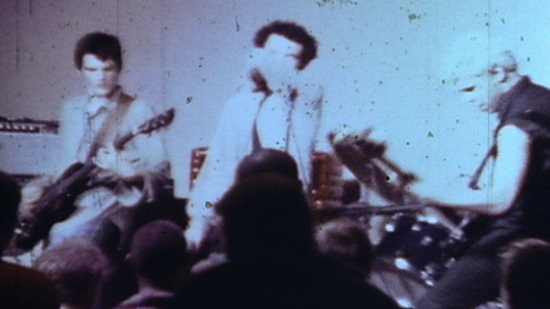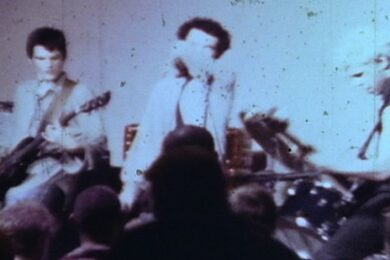Filmmaker James Schneider works out of the twin capitals of Paris and Washington DC making narrative, documentary and experimental pieces. Whether it’s films about the gospel yeah-yeah sound of The Make-Up, Chilean legends Panico, the DC punk scene or the city of DC itself, he focuses on the power of culture to transform. Here James talks through just a few of his films and the inspirations behind them.
Punk The Capital (2014)
For the past ten years, James and co-director Paul Bishow have been painstakingly making a documentary about the early years of DC punk using archive footage, much of which was filmed by Bishow at the time and has never been seen before.
James Schneider: "I grew up in Northwest DC, straddled between the skate and the punk scene. I started going to shows in the mid-80’s catching the tail end of bands like Rites of Spring. That music became the musical backbone of my existence.
"What I really remember is the audience and talking out on the street. It was really this communal experience that’s hard to explain, even though it was a big deal when I saw things like Fugazi’s first show.
"Paul is part of an even earlier generation. That first blast of punk starting in 79/80, part of the Madam’s Organ world at that time. His perspective is different so we are merging our two perspectives together to yield something interesting.
"We started with this huge brief running from the start of punk up to the Fugazi era. We’ve trimmed it down to focus on the late seventies up until the hardcore period and touching on Revolution Summer. We don’t want any outside production companies taking this on. It’s not for HBO, so it’s taken more time but it’s definitely benefitted from that.
"The most important thing is making something that feels like it came from the inside out. This is less of a film about DC than for DC. It will feel like it was made by DC, rather than by Paul and I."
The Band That Met The Sound Beneath (2012)
Paris based Chilean band Panico planned to take a pilgrimage to Northern Chile, an area drenched in traditional history and haunted by the ghosts of the country’s recent past. While there, they decided to record an album directly influenced by the atmosphere of the region, which was to have a profound effect on them.
JS: "These guys were in Paris, most of them are children of political exiles from Chile. The cameraman for the science fiction film I made was good friends with them so he recommended me. One of them was a huge fan of The Make-Up and put the pieces together that I’d made a film about them, so then the deal was done.
"The project was to go up to the north of Chile and record the sounds and voices in this magical and haunted part of the country. I’d never been to Chile before so here I was directing a film in a foreign language, three weeks on a bus with a band going to these strange places.
"The north, to them, was this symbolic place in terms of openness after Pinochet left power. Also because it was where the concentration camps had been. So it has a very dark history, but also has a history that goes back thousands of years.
"While we were on the road there was an earthquake. We had just filmed a scene on these dunes, trying to get them to sing. There are singing dunes around the world where, if you push the sand the right way, there’s this tone that comes out of them. It’s an amazing thing. We were working all day trying to make them sing and rubbing them. It felt like the earth was shaking because the dunes create this pulse that goes across the sand. Then there was the earthquake. The band tricked me into thinking the authorities were looking for these people that were in the dunes trying to make the earth tremble and so were responsible for the quake."
Jean Epstein, Young Oceans Of Cinema (2011)
Jean Epstein, who died in 1953, was a Polish born filmmaker and critic working in France, perhaps best known for his 1928 version of The Fall of the House of Usher, which he adapted with Luis Bunuel.
JS: "I decided to move to Paris for a year to get my Masters in Philosophy. It wound up being 12. I continued making films over there and found that the system of film financing was a lot more amenable to the kind I was making.
"Jean Epstein was really an outsider. He eschewed the path of recognition. He was in the company of people like Dali and Bunuel but took off to Brittany to basically work with a new kind of avant-garde perspective, working much closely with the reality of people at that time.
"It’s kind of a DC type thing. He was not considering his own self-promotion. He was only at the service of his art. He sacrificed himself for cinema. His writings are perhaps the most impressive part of his work. He produced huge volumes of amazing film theory that I would highly recommend.
"Over the years a lot of people who have worked in film have had mentors. I spent an enormous amount of time reading Epstein’s correspondence and his texts and basically felt like I was having a dialogue with him even though he’s gone. In a lot of ways he became my mentor."
Degradation Films (2006-2008)
Using various tools such as needles, x-rays and the ravages of time, film stock itself, as well as the images present on it, can take on new forms.
JS: "The degradation films were basically made by x-rays. They were made collectively by all the security personnel from dozens of airports around the world. I sent these films out with people who travel a lot and said ‘put it in your luggage’. So they were being x-rayed and it was this effect that little by little erased the image.
"The second one we did was of the Capital building. I filmed the footage then we gradually erased it using the x-rays of government buildings. It’s interesting to think of what filters you put a film through, whether it’s screenings or testing it on different machines. These filters you put a film through make it yield the unexpected."
The End Of The Light Age (aka 1,2,3 Whiteout) (2007)
A science-fiction fantasy combining found footage, archival materials and narrative elements to create a strange and dazzling experience.
JS: "In any urban space you are confronted with this massive illumination all the time. With Super-Max prisoners they now keep a light on constantly. You have this long tradition of light being good, this powerful force that will bring clarity to the world. So I wanted to make a science fiction film that used this notion of light as this aggressive element with a scientist that’s created a machine that produces darkness.
"We had shot most of this before we had written a script. It was sound and image that I had picked up over the years that I fed into it. It makes for an interesting approach because I could go to Lou Castel and Karine Adrover and say "this is the world you are going to be inhabiting".
"This was also one of the last 16mm films edited on the east coast. The woman who cut the negative, she’d been cutting Spike Lee’s negatives up in New York and she said "this is the last one". I miss working on an editing table as you have this physical machine that you have to move and I think that energy enters into the film."
The New Ball Game (2006)
To make way for the new Washington Nationals baseball stadium, many locals in the area were forcibly evicted, a process that James documented.
JS: "I started making a film with a friend of mine who used to dance in the gay nightclubs in that particular part of DC. Then I realised the neighbourhood was going to be wiped from the face of the earth. It was part of DC that still had some life and grit to it.
"I started filming down there and getting to know the inhabitants and looking into what the politicians were up to. I cut the film together as a sort of agitprop piece before the elections of 2006. Some of the politicians were in the pocket of the development firms, so I wanted to do my part in seeing that they didn’t get elected."
Blue Is Beautiful (1997)
Rather than making a traditional tour film, James joined the legendary DC outfit The Make-Up for a semi-fictional mix of politics, provocation and propaganda.
JS: "The Make-Up had seen a film that I made with Combustible Edison called Oasis. So we decided to hit the road and write this film as we went along on a short tour they took up to Canada.
"Every night before the concerts we would talk about the different themes that were starting to emerge. Then Ian (Svenonius), the genius that he is, would weave that into the sing-speak songs that he had. So we created this integrated object.
"I was working with them as part of the band. I didn’t see much separation between what I was doing and what they were doing. I think you can see where the audience and the band are in this orgy of energy and I just dived right in with the camera and tried to be part of that."
James & Paul are currently conducting a Kickstarter campaign to complete Punk The Capital. If you’d like to contribute there is more information at https://www.kickstarter.com/projects/1137256310/punk-the-capital-straight-from-washington-dc
For more on James visit http://info.jamesjune.info/



